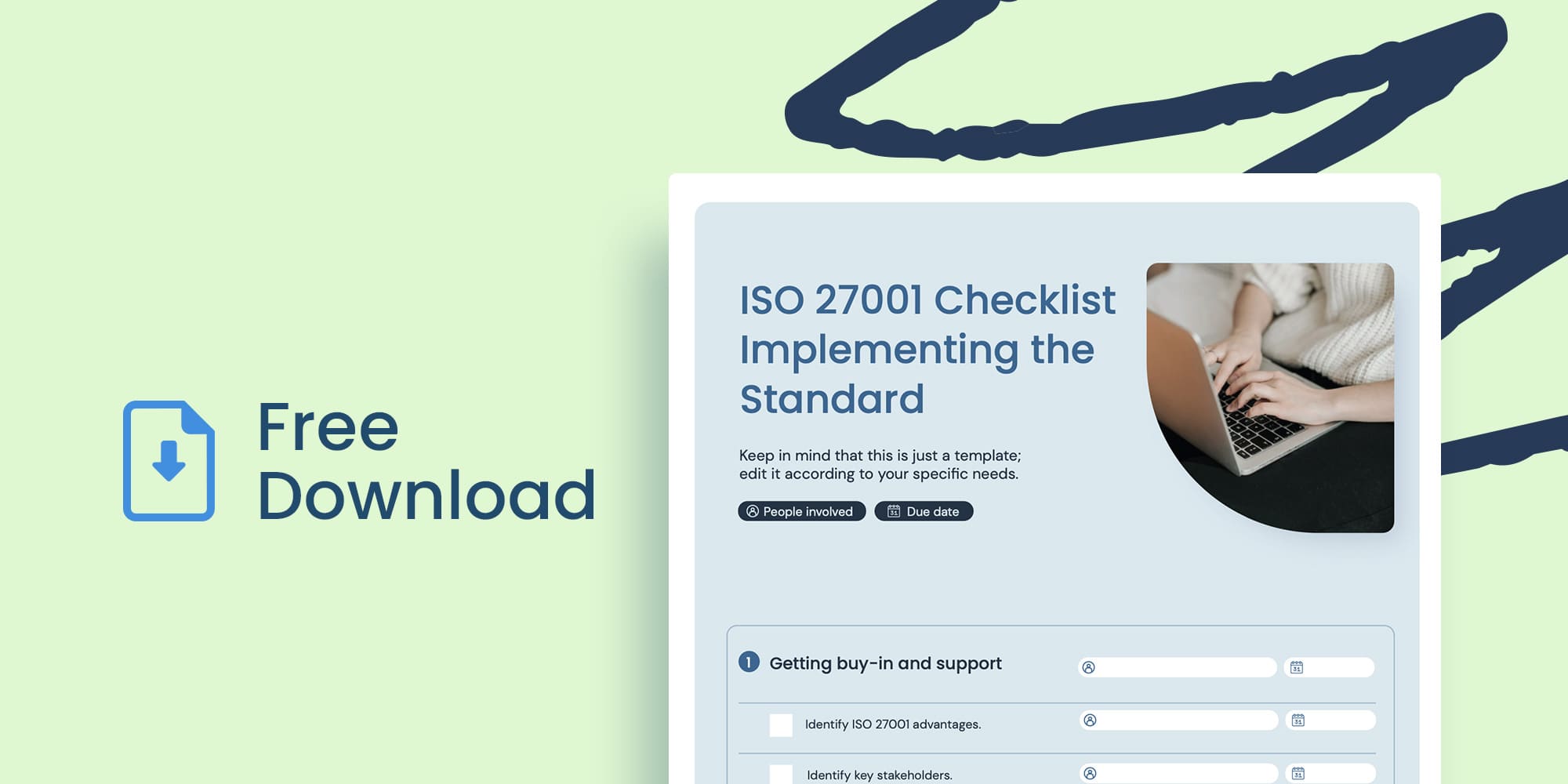Managing incidents is crucial to maintaining the security and integrity of an organization's information systems. ISO 27001 Incident Management provides a structured approach to addressing and resolving incidents in a way that minimizes impact and prevents recurrence.
This framework doesn't just help organizations respond to incidents—it helps them create a robust system that anticipates and mitigates risks before they escalate.
With ISO 27001, organizations can establish a systematic process for handling incidents, ensuring compliance with international standards and bolstering their overall IT security posture. But what exactly does ISO 27001 Incident Management entail, and how can you implement it effectively within your IT Service Management (ITSM) strategy?

What is ISO 27001 Incident Management?
ISO 27001 is an internationally recognized standard for information security management systems (ISMS). It provides a comprehensive framework for managing sensitive company information, ensuring it remains secure and protected from threats. Within IT Service Management, ISO 27001 plays a crucial role in defining how incidents should be managed.
ISO 27001 defines Incident Management as the process of identifying, reporting, and resolving security incidents to minimize their impact on the organization. While ITSM encompasses various frameworks like ITIL, COBIT, and NIST, ISO 27001 stands out for its focus on information security. It provides clear guidelines on how to handle incidents systematically, ensuring that every step taken aligns with the organization's broader security objectives.

The evolution of ISO 27001 Incident Management
ISO 27001 Incident Management has evolved significantly since its inception, reflecting changes in the threat landscape and advances in technology. Here’s a look at how the framework has developed over time.
Early beginnings
ISO 27001 was first introduced as ISO/IEC 27001:2005, focusing primarily on establishing an information security management system (ISMS). The initial framework provided basic guidelines for Incident Management, emphasizing the need for a structured approach to handling security incidents.
The 2013 revision
In 2013, ISO/IEC 27001:2013 was released, bringing several updates to the framework. This revision introduced more detailed requirements for Incident Management, including a greater emphasis on risk assessment and the integration of Incident Management with the organization’s broader ISMS. The 2013 version aimed to enhance the effectiveness of Incident Management by aligning it with the organization’s overall security objectives.
The 2022 update
The most recent update, ISO/IEC 27001:2022, continued to refine the Incident Management process, incorporating feedback from practitioners and advancements in cybersecurity. This version introduced more specific requirements for documenting and tracking incidents, as well as improved guidelines for conducting post-incident reviews. The 2022 update reflects the growing complexity of the threat landscape and the need for a more dynamic and adaptive approach to Incident Management.
How to implement ISO 27001 Incident Management?
1. Establish an Incident Management policy
The first step in implementing ISO 27001 Incident Management is to establish a clear policy that outlines how incidents will be managed within the organization. This policy should define the scope of Incident Management, roles and responsibilities, and the procedures for reporting, responding to, and resolving incidents.
2. Develop an Incident response plan
Next, organizations need to develop a detailed incident response plan that outlines the specific steps to be taken in the event of an incident. This plan should include procedures for identifying, reporting, assessing, containing, eradicating, and recovering from incidents. It should also include guidelines for conducting post-incident reviews and implementing lessons learned.
3. Train your team
Once the policy and plan are in place, it's essential to train your team on how to respond to incidents effectively. This includes regular training sessions, simulations, and drills to ensure that everyone knows their role in the Incident Management process. ISO 27001 emphasizes the importance of continuous training and awareness to keep the team prepared for any incident.

4. Implement monitoring and detection tools
To effectively manage incidents, organizations need to implement monitoring and detection tools that can identify potential threats in real-time. This includes network monitoring, intrusion detection systems, and other security tools that can help identify incidents as they occur. These tools should be integrated into the organization's broader IT infrastructure to ensure comprehensive coverage.
6. Conduct regular audits and reviews
Finally, organizations should conduct regular audits and reviews of their Incident Management process to ensure that it remains effective and compliant with ISO 27001. This includes reviewing incident logs, conducting post-incident analyses, and updating the Incident Management policy and plan as needed. Regular audits help identify gaps in the process and ensure continuous improvement.
How to approach Incident Management as per ISO 27001? Step-by-step process
Step 1: Identification
The first step in ISO 27001 Incident Management is identifying potential security incidents. This involves monitoring systems, networks, and applications for any signs of unusual activity that could indicate a security breach or other incident. Early identification is crucial for minimizing the damage and ensuring a swift response.
Step 2: Reporting
Once an incident is identified, it needs to be reported immediately to the relevant stakeholders. This includes the IT team, security officers, and any other personnel responsible for incident response. ISO 27001 emphasizes the importance of a clear reporting structure to ensure that incidents are communicated quickly and effectively.
Step 3: Assessment
After an incident is reported, it must be assessed to determine its severity and potential impact. This assessment helps prioritize the response and allocate resources accordingly. ISO 27001 provides guidelines for assessing incidents based on their potential to disrupt business operations, compromise data, or cause financial loss.
Step 4: Containment
The next step is to contain the incident to prevent it from spreading and causing further damage. This could involve isolating affected systems, shutting down compromised networks, or applying temporary fixes to prevent the incident from escalating. Containment is a critical step in minimizing the impact of an incident.
Step 5: Eradication
Once the incident is contained, the focus shifts to eradicating the root cause. This might involve removing malware, patching vulnerabilities, or addressing other underlying issues that led to the incident. ISO 27001 stresses the importance of thorough eradication to ensure that the incident does not recur.
Step 6: Recovery
With the threat eliminated, the next step is to recover any lost data, restore affected systems, and return to normal operations. This could involve data backups, system restores, or other recovery measures. ISO 27001 emphasizes the need for a well-defined recovery process to minimize downtime and restore business continuity.
Step 7: Lessons learned
The final step in the ISO 27001 Incident Management process is to review the incident and identify lessons learned. This involves analyzing what went wrong, what was done well, and what could be improved in future incident responses. The goal is to continuously improve the Incident Management process and prevent similar incidents from occurring in the future.

Benefits of ISO 27001 Incident Management
1. Improved security posture
One of the primary benefits of ISO 27001 Incident Management is the improvement in an organization's overall security posture. By following the framework's guidelines, organizations can create a robust system that not only responds to incidents but also anticipates and mitigates risks before they escalate.
2. Enhanced compliance
ISO 27001 is an internationally recognized standard, and implementing its Incident Management process helps organizations ensure compliance with global security regulations. This is particularly important for organizations that operate in highly regulated industries, where compliance is critical to avoiding fines and penalties.
3. Streamlined incident response
ISO 27001 provides a clear and structured approach to Incident Management, which helps streamline the response process. This reduces the time it takes to identify, contain, and resolve incidents, minimizing their impact on the organization.
5. Continuous improvement
The ISO 27001 framework emphasizes continuous service improvement, which means that organizations are constantly reviewing and refining their Incident Management processes. This leads to a more resilient system that can adapt to new threats and challenges over time.
6. Better Risk Management
By implementing ISO 27001 Incident Management, organizations can better manage the risks associated with security incidents. This includes identifying potential threats, assessing their impact, and implementing measures to mitigate them. Stronger Risk Management leads to fewer incidents and less disruption to business operations.
Challenges of ISO 27001 Incident Management
1. Complexity of implementation
ISO 27001's Incident Management framework can challenge organizations, particularly those with limited resources or experience in information security. The framework requires a significant investment in time, resources, and expertise to implement effectively.
2. Keeping up with evolving threats
The threat landscape constantly evolves, so organizations must stay ahead of new and emerging threats. This requires continuous monitoring, updating of incident response plans, and regular training to ensure that the team is prepared to respond to the latest threats.

3. Balancing security and usability
Another challenge of ISO 27001 Incident Management is balancing the need for robust security with the need for usability. Implementing strict security measures can sometimes make systems more difficult to use, which can lead to resistance from users. Organizations need to find a balance that ensures security without compromising usability.
4. Maintaining compliance
Organizations may find it challenging to maintain compliance with ISO 27001, particularly as they grow and evolve. This requires regular audits, updates to the Incident Management process, and ongoing training to ensure that the organization remains compliant with the framework.
What should an ISO 27001 Incident Management tool have?
1. Real-time monitoring and detection
An effective ISO 27001 Incident Management tool should include real-time monitoring and detection capabilities to identify potential threats as they occur. This includes network monitoring, intrusion detection, and other security tools that can provide real-time alerts and notifications.
2. Incident tracking and reporting
The tool should also include robust incident tracking and reporting features that allow organizations to document and track incidents from identification through resolution. This includes the ability to generate reports, track metrics, and conduct post-incident reviews.
3. Integration with other security tools
An ISO 27001 Incident Management tool should be able to integrate with other security tools and systems within the organization. This includes integration with SIEM (Security Information and Event Management) systems, threat intelligence platforms, and other security solutions to provide a comprehensive view of the organization's security posture.
4. Automated response and remediation
Automated response and remediation capabilities are also essential for an ISO 27001 Incident Management tool. This includes the ability to automatically contain incidents, apply patches, and execute other response actions to minimize the impact of an incident.
5. User-friendly interface
Finally, the tool should have a user-friendly interface that makes it easy for the incident response team to navigate and use. This includes intuitive dashboards, easy-to-use reporting features, and the ability to customize the tool to fit the organization's specific needs.

To sum up
ISO 27001 Incident Management provides a structured approach to handling security incidents that helps organizations minimize their impact and prevent recurrence.
By following the framework's guidelines, organizations can improve their security posture, ensure compliance with global standards, and streamline their incident response process.
Implementing ISO 27001 Incident Management is not without its challenges. Implementing this framework requires a significant investment in resources, expertise, and time. However, the benefits of improved security, enhanced compliance, and better risk management far outweigh these challenges. By leveraging the right tools and continuously refining their processes, organizations can effectively manage incidents and protect their valuable information assets.
Ultimately, ISO 27001 Incident Management is about creating a culture of security within the organization. It's about ensuring that everyone, from the IT team to the executive leadership, understands the importance of managing incidents effectively and is committed to upholding the organization's security standards. By embedding these principles into the organization's DNA, businesses can build a more resilient and secure future.
Frequently Asked Questions (FAQs)
1. What is the difference between ISO 27001 and ITIL in Incident Management?
ISO 27001 focuses specifically on information security management, while ITIL covers a broader range of IT Service Management practices. ISO 27001 provides a structured approach to managing security incidents, whereas ITIL offers guidelines for managing incidents in general, including those not related to security.
2. How often should organizations review their ISO 27001 Incident Management process?
Organizations should conduct regular reviews of their ISO 27001 Incident Management process at least annually or after significant incidents. Regular audits, post-incident analyses, and updates to the Incident Management plan are essential to maintaining compliance and improving the effectiveness of the process.
3. What are the key components of an ISO 27001 Incident Management policy?
An ISO 27001 Incident Management policy should include the scope of Incident Management, roles and responsibilities, procedures for reporting and responding to incidents, and guidelines for conducting post-incident reviews. It should also outline the tools and technologies used for monitoring, detection, and response.
4. Can smaller organizations implement ISO 27001 Incident Management effectively?
Yes, smaller organizations can implement ISO 27001 Incident Management effectively by tailoring the framework to their specific needs and resources. While the implementation may be more challenging due to limited resources, the principles of ISO 27001 can be scaled to fit the organization's size and complexity, ensuring robust security practices are in place.














.jpg?upsize=true&upscale=true&width=780&height=205&name=ITIL%20Foundation%20Exam%20(2).jpg)
